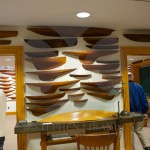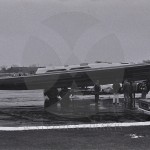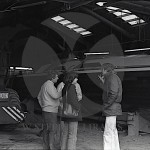Dymaxion blueprints discovered in attic going up for auction

Photos courtesy Wright Auctions.
Long hidden away in a New England attic, a set of blueprints for the futuristic Dymaxion automobile – allegedly the only privately held Dymaxion artifacts – are now seeing the light of day as they head to auction next month.
Collected in a three-ring binder, the set of 18 blueprints all appear to date to 1933 and cover chassis details, metal specifications, and wiring diagrams for the first and second Dymaxion cars, which Buckminster Fuller and Starling Burgess designed and built in the old Locomobile factory in Bridgeport, Connecticut. The blueprints turned up only recently in the attic of a house in Dudley, Massachusetts; the discoverer then donated the blueprints to filmmaker Noel Murphy, who will use the proceeds from the sale to help finish his documentary on the Dymaxion.
“We don’t know exactly how the blueprints got to that attic, but we can put two and two together,” Murphy said. “When Nannie Dale Biddle Else Foss (a financial backer of the 4D Company, which produced the Dymaxion) ended up with controlling interest in the company, Buckminster Fuller hid Dymaxions No. 2 and 3 at Waterhouse in Webster, Massachusetts. So the best I can figure is that when he hid the cars, he lived in a rooming house near there, and Dudley is just one town over from Webster.”
According to Murphy, the blueprints going up for auction are the only known set of original Dymaxion blueprints outside of Stanford University’s Dymaxion Chronofile archives, which includes the complementing body blueprints for Dymaxion No. 1. “Nothing [original related to the Dymaxion automobile] is in private hands,” Murphy said. “We spent plenty of time and a lot of searching looking for other Dymaxion materials.”
Fuller envisioned the Dymaxion automobile – a front-wheel-drive Ford flathead-powered rear-engine three-wheeler with rear-wheel steering and a teardrop-shaped body – as part of an overall philosophy that combined urban planning, architecture, and social criticism. He enlisted yacht builder Starling Burgess to design the unique vehicle and built three Dymaxions in total: The first became involved in the infamous fatal accident in Chicago, then later became a productmobile for a while before being destroyed by a fire; the second, the only Dymaxion extant, today resides in the National Automobile Museum in Reno, Nevada; and the third was reportedly scrapped during the Korean War in Wichita, Kansas. Crosthwaite and Gardiner recently completed a re-creation of Dymaxion No. 3 for British architect Lord Norman Foster, and Jeff Lane of the Lane Motor Museum has embarked on his own Dymaxion re-creation.
Murphy said that his film, The Last Dymaxion: Buckminster Fuller’s Dream Restored, should be finished in the fall.
The blueprints, which will appear in the Wright Auctions Important Design sale June 6 in Chicago, are estimated to sell for $20,000 to $30,000. For more information, visit Wright20.com.
Two people I have always found most interesting, Starling Burgess was a complicated man, who in my opinion has never been recognized adequately for his genius. His drawings, at Mystic Seaport are marvels. I attended several lectures by Buckminster Fuller when I was young.






























